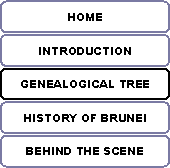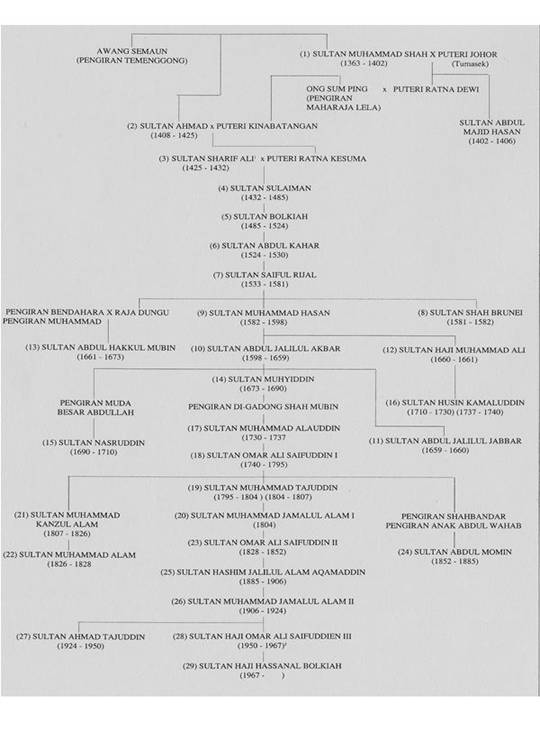



|
GENEALOGICAL TREE OF BRUNEI'S SULTAN |
|
Sultan Muhammad Shah was the first Sultan of Brunei from 1363-1402. His Royal Highness married with Johor's princess. Before he was well-known as Awang Alak Betatar. His grandfather named Sang Aji. He inherited 'Naubat', 'Ganta' and 'Aamat' from Minangkabau, Negeri Andalus. In 1371, His Royal Highness sent a delegate to China and Chinese called him as Ma-ha-mo-sha. His Royal Highness died in 1402. |

|
(1) Sultan Muhammad Shah |

|
(2) Sultan Ahmad |

|
In 1408 Sultan Ahmad ascended a throne and before was known as 'Pateh Berbai'. He was the first 'Pengiran Bendahara' of Brunei and first found named 'Brunei' originate from the word 'Baru nah'. His Royal Highness died in 1425. . |

|
(3) Sultan Sharif Ali |
|
Sultan Sharif Ali, Sultan Berkat, was originated from Taif, Arabia, who married a daughter of the second Sultan, and later ascended a throne as the third Sultan in 1425. He was the first to build a mosque and reinforce the Islamic faith in Brunei. He also built the Kota Batu (Stone Fort). He introduced the sword of Bongkok and flags of Brunei. His Royal Highness died in 1432. |

|
[4]Sultan Sulaiman |
|
Sultan Sulaiman ruled Brunei from 1432 to 1485. He continued the work of building Kota Batu and propagated the Islamic teaching, succeeded Sultan Berkat. He was well known as 'Adipati Agong' or 'Sang Aji Brunei'. He descended from the throne in 1485 and died in 1511. |

|
[5] Sultan Bolkiah |
|
Sultan Bolkiah, whose conquests covered the whole of Borneo and as far north as Luzon in the Philippine Islands, where he initiated the spread of Islam, succeeded Sultan Sulaiman. He was known as Nakhoda Ragam. His queen was known as Puteri Laila Menchanai.
|
|
The reign of Sultan Bolkiah (1485-1524) was the height of the Brunei Sultanate in territory, influence and power. Brunei's sovereignty then extended to encompass other kingdoms in Borneo and the Philippines (then dominated by the Kingdom of Manila and the Sultanates of Sulu and Maguindanao). Islam spread to the Philippines, particularly to the islands of Sulu in the south. |

|
[6]Sultan Abdul Kahar |
|
Sultan Abdul Kahar (1524-1530) was the sixth Sultan of Brunei. He was a pious person endowed with supernatural powers (berkeramat). In 1521, Ferdinand Magellan and Antonio Pigafetta visited him while he was a deputy (Pemangku Sultan).During his time, many Islamic theologians came to Brunei to spread the Islamic teachings. He created the currency unit 'pitis'. He descended from the throne in 1530 and was known as Paduka Seri Begawan Sultan Abdul Kahar. He died in 1578 and was well-known as 'Marhum Keramat'. |
|
[7]Sultan Saiful Rizal |
|
From 1533 until 1581,Brunei was ruled by Sultan Saiful Rizal. He propagated Islamic teachings throughout Borneo as well as the Philippines, succeeded Sultan Abdul Kahar, whose death was recorded by the Spaniards in 1578. |
|
Brunei became well known as the Islamic Development Centre. He was mentioned by name in Spanish accounts and is the first Sultan of Brunei to be identified by any non-indigenous account. In 1578 when the Spain attacked Brunei, Brunei's Mosque (Jame') was burnt by them. He died in 1581. |
|
[8]Sultan Shah Brunei |
|
The eighth Sultan of Brunei ascended a throne in 1581. He had no heir. In 1582, he handed over his throne to his younger brother, Sultan Muhammad Hasan. |

|
(9) Sultan Muhammad Hasan |
|
Famous for his strength, Sultan Muhammad Hasan (1582-1598) had the same power as Sultan Iskandar Muda Nahkota Alam, Acheh. His reign was known as Pengiran Di Gadong and Pengiran Pemancha. He was very active in propagating Islamic teachings. His representative was changed status to 'Duta'. His palace was surrounded with defensive walls.He ordered Pehin Orang Kaya Di-Gadong Seri Lela to attack Milau (Sarawak). In 1598, he died and was known as 'Marhum di Tanjung'. |
|
(10) Sultan Abdul Jalilul Akbar |

|
In 1598, Sultan Abdul Jalilul Akbar ascended the throne. When he ascended the throne, he was helped by his uncle, Pengiran Di-Gadong Besar Osman. In 1599, he developed a relationship with the Spaniards in Manila. He died in 1659 and was well-known as 'Marhum Tua'. |

|
Sultan Abdul Jalilul Jabbar made himself a great name for his fairness and peace and harmony was maintained during his rule from 1659-1660. In 1660, he died and was known as 'Marhum Tengah'. |
|
(11) Sultan Abdul Jalilul Jabbar |

|
(12) Sultan Haji Muhammad Ali |
|
Sultan Haji Muhammad Ali succeeded Sultan Abdul Jalilul Jabbar in 1660. His throne was seized by Pengiran Bendahara Abdul Hakkul Mubin because his son was stabbed by Pengiran Muda Bungsu who was lost in a fighting-cock. He was killed at afternoon prayer on 6 November 1661. He was well known as "Marhum Tumbang Di Rumput." |

|
(13) Sultan Abdul Hakkul Mubin |
|
Sultan Abdul Hakkul Mubin ascended a throne in 1661. He seized the throne from Sultan Haji Muhammad, then Pengiran Muda Muhyiddin took revenge. This caused civil war to happen for twelve years. His Royal Highness built a palace and state at Pulau Chermin. In 1673, he died and was known as 'Marhum di Pulau'. |

|
(14) Sultan Muhyidin |
|
Sultan Muhyiddin (1673-1690) was well known for his wisdom, strength and capabilities of uniting the people after the civil war. In the latter half of the 17th century between the reign of Sultan Abdul Hakkul Mubin (the 13th Sultan) and Sultan Muhyiddin (the 14th Sultan) there was civil war in Brunei which, among other factors, caused the break up of Brunei territories in many parts of Borneo and the Philippines. In the 18th and 19th centuries, Brunei borders were the Sambas River in the west and Sibuku River in the east. In 1690, he died. He was well known as 'Marhum Bungsu'. |

|
Sultan Nasruddin (1690-1710) introduced gold coins during his reign in 1690-1710. During his time, Dato Godam came to Brunei. He died in 1710 and was known as 'Marhum di Kianggeh'. |
|
(15) Sultan Nasruddin |




|
Sultan Husin Kamaluddin ascended the throne twice, in 1710-1730 and 1737-1740. Endowed with supernatural powers, he was able to transform 'buah ngirih', a fruit, to 'pitabu', another fruit. He ascended the throne twice and finally lived in Luba. He created a currency unit 'pitis'. He died in 1770 and was well known as "Marhum di Luba". |
|
(16) Sultan Husin Kamaludin |

|
Sultan Muhammad Alauddin (1730-1737) documented the Laws of Regulations of Bruneian Kings, (Salasilah Raja-Raja Brunei) and produced the currency "pitis". He was well known as "Marhum di Brunei". |
|
(17) Sultan Muhammad Alauddin |

|
Sultan Omar Ali Saifuddien I ruled Brunei from 1740 to 1795. In 1769, he ordered the attack to Manila, which was captured. In 1795, he died and was well known as "Marhum di Makam Besar". |
|
[18] Sultan Omar Ali Saifuddien 1 |

|
Sultan Muhammad Tajuddin (1795-1804 and 1804-1807) ordered the building of houses for the Brunei pilgrims in Mecca. In 1795, Sultan Muhammad Tajuddin ascended a throne. He abdicated from the throne two times. He was the Brunei's Sultan who had send a delegation to China to sell Brunei's belongings there. Sultan Muhammad Tajuddin ordered the building of houses for the Brunei pilgrims in Mecca. He died in 1807. |
|
[19] Sultan Muhammad Tajuddin |

|
Sultan Muhammad Jamalul Alam I ascended a throne in 1804. His reign was not long but his descendants continued until now. |
|
[20] Sultan Muhammad Jamalul Alam I |

|
Sultan Muhammad Kanzul Alam (1807-1826) acted for Sultan Muhammad Tajuddin and looked after the Bruneian government for the latter's son, Sultan Omar Ali Saifuddien II. During his time, Pengiran Muhammad Salleh was appointed as Pengiran Indera Mahkota and ordered to control Sarawak. In 1826, he descended from the throne. |

|
[21] Sultan Muhammad Kanzul Alam |
|
In 1826, His Royal Highness ascended a throne that was during his father's life. Sultan Muhammad Alam was well known for his strength and power and was also called Raja Api (King of Fire). He died in 1828. |

|
[22] Sultan Muhammad Alam |
|
His royal highness was the 23rd Sultan of Brunei from 1828 until 1852. He was the son of Sultan Muhammad Jamalul Alam I. He became Sultan after overthrowing the then Sultan, his cousin Muhammad Khanzul Alam. The reign of Sultan Omar Ali Saifuddin II marked the beginning of direct European involvement in Brunei. Between 1842 and the end of the century saw the Brooke's involvement in Sarawak and the British Chartered North Borneo company in Sabah, which further eroded Brunei territory to its present split-halves. He surrendered Labuan Island to the English in 1846. He signed a treaty with the English on trade and good relationship. On his royal highness death in 1852, he was succeeded by a cousin, Abdul Momin. |

|
[23] Sultan Omar Ali Saifuddin II |
|
In 1852, Sultan Abdul Momin ascended the throne. He had no heir. He was well known for his fairness, wisdom, and was endowed with supernatural powers. In 1877 he signed a treaty concerning the leasing of Brunei's territory in Sabah. In 1884, he ordered Pengiran Temenggong Pengiran Anak Hashim to attack Limbang to restore peace. In 1885, he died at the age of more than 100 years old. |
![Cloud Callout: [24]
Sultan Abdul Momin](image646.gif)
|
Sultan Hashim was the son of Sultan Omar Ali Saifuddin II. He succeeded Sultan Abdul Momin as the 25th Sultan of Brunei. He ruled Brunei from 30 May 1885 till 10 May 1906. During his reign, the first postage stamps was introduced in Brunei. He died in May 1906 at the age of eighty. |
|
[25] Sultan Hashim |

|
Sultan Muhammad Jamalul Alam II was the eldest son of Sultan Hashim and became the 26th Sultan of Brunei in 1906. Being so young, the responsibility of the Sultan was in the hands of the "Majlis Pemangku Raja" that is the Council of Regency. He was crowned as Sultan in 1918 at the age of 29. The first world war took place during his reign. His support and cooperation to the British government earned him the titles of Companion of the Order Saint Michael and Saint George (CMG) in 1914 and in 1920, he received a higher distinction - Knight Commander of the Order of Saint Michael and Saint George (KCMG). The Sultan's reign was not a long one. He died on the 19th September,1924 at the age of 35 from Malaria. |

|
[26] Sultan Muhammad Jamalul Alam II |
|
The 27th Sultan of Brunei was Sultan Ahmad Tajuddin. His Royal Highness was born on 22 August 1913 at the palace in Brunei town. He was only eleven years old when he ascended the throne. Being a minor, two Wazirs were appointed as regents to rule Brunei until he came of age. He was the first Sultan to receive formal education at the palace. On 19 September 1931, at the age of eighteen, His Royal Highness assumed power. The coronation took place on 17 March 1940. He died of a haemorrhage in Singapore on 4 June 1950, at the age of 36. Sultan Ahmad Tajuddin didn't have a male heir, thus his brother Pengiran Omar Ali Saifuddin succeeded to the throne. |

|
[27] Sultan Ahmad Tajuddin |
|
[28] Sultan Omar Ali Saifuddien III |

|
His Royal Highness ruled Brunei from 1950 to 1967. He succeeded his brother Sultan Ahmad Tajuddin as the 28th Sultan of Brunei. He was born on 23 September 1914 in Kampung Sultan Lama, Brunei Town. During his reign, he set out to work for an improved standard of living for all his people. As a result, it witnessed economic, social and political development. It took brunei forward as a modern country in the twentieth century. His Royal Highness' determination had brought Brunei to international attention and recognition and this earned him to the title 'The Architect of Modern Brunei'. The greatest achievement of His Royal Highness was the signing of the 1959 Constitution Agreement where Malay Language and Islam were strengthened. Brunei's first currency note issued in 1967. On 4 October 1967, Sultan Omar Ali Saifuddien III voluntarily abdicated in favour of his eldest son, Yang Teramat Mulia Seri Paduka Duli Pengiran Muda Mahkota Hassanal Bolkiah. After the abdication, Sultan Omar Ali Saifuddien III was known as Duli Yang Teramat Mulia Paduka Seri Begawan Sultan Sir Muda Omar Ali Saifuddien Sa'adul Khairi Waddien. When Brunei gain full independence in 1984, His Royal Highness became the Minister of Defence. His Royal Highness died peacefully on 7 September 1986. He was laid to rest in the Royal Mausoleum. |
|
[29] Sultan Hassanal Bolkiah Muizzadin Waddaulah |

|
His majesty was born on 15 July 1946 at Istana Darussalam, Bandar Seri Begawan. On 14 August 1961 His Majesty Paduka Seri Baginda Sultan and Yang Di-Pertuan of Brunei Darussalam was installed as the Crown Prince. On 4 October 1967, His Majesty ascended to the throne and crowned as the 29th Sultan of Brunei on 1 August 1968. |